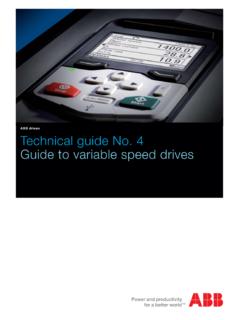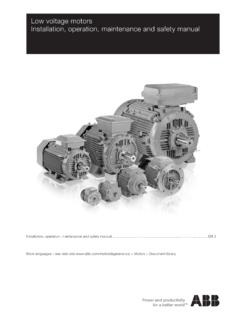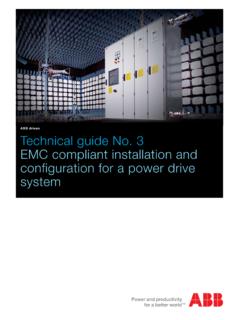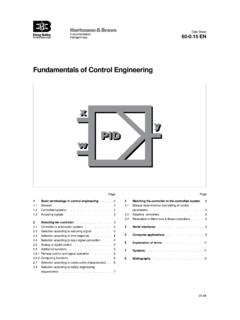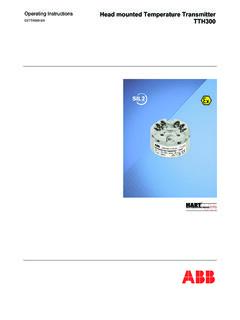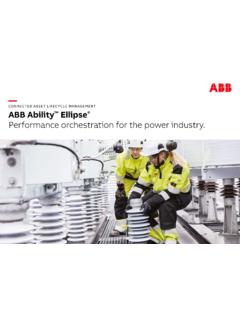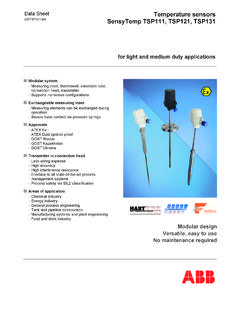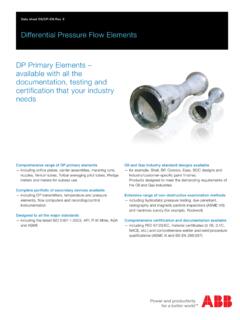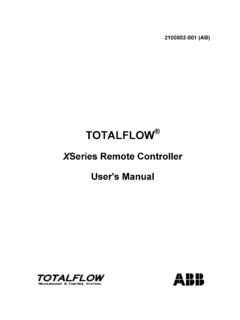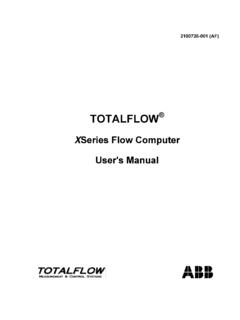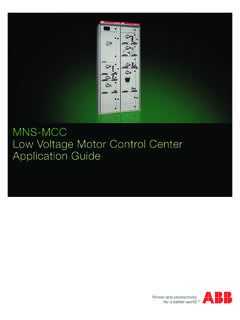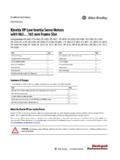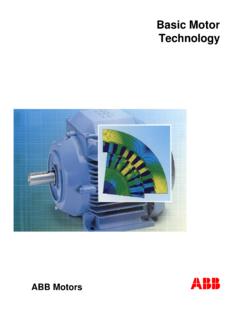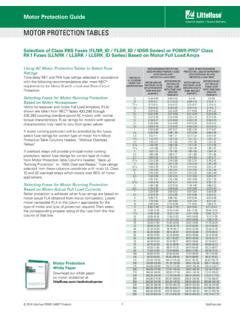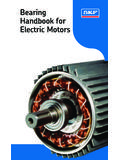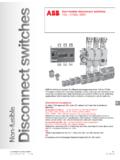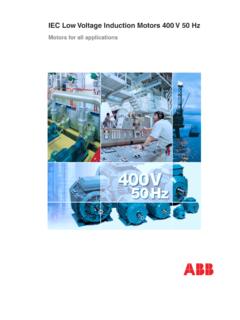Transcription of ABB drives Technical guide book
1 Technical guide bookABB drives2 ABB drives I Technical guide bookTechnical guide book I ABB drives 3 Copyright 2014 ABB. All rights reserved. Specifications subject to change without REV H drives - Technical guide book4 ABB drives I Technical guide bookTechnical guide book I ABB drives 51. Direct torque control explains what DTC is; why and how it has evolved; the basic theory behind its success; and the features and benefits of this new EU Council Directives and adjustable speed electrical power drive systems is to give a straightforward explanation of how the various EU Council Directives relate to power drive EMC compliant installation and configuration for a power drive system assists design and installation personnel when trying to ensure compliance with the requirements of the EMC Directive in the user s systems and installations when using AC guide to variable speed drives describes basics of different variable speed drives (VSD)
2 And how they are used in industrial Bearing currents in modern AC drive systems explains how to avoid guide to harmonics with AC drives describes harmonic distortion, its sources and effect, and also distortion calculation and evaluation with special attention to the methods for reducing harmonics with AC Dimensioning of a drive system. Making dimensioning correctly is the fastest way of saving money. Biggest savings can be achieved by avoiding very basic mistakes. These dimension-ing basics and beyond can be found in this Electrical braking describes the practical solutions available in reducing stored energy and transferring stored energy back into electrical guide to motion control drives gives an overview of high performance drives and motion Functional safety guide introduces the Machinery Directive and the standards that must be taken into account when design-ing a machine, in order to ensure operational guide No.
3 1 Direct torque control -the world s most advanced AC drive technologyABB drives2 Direct torque control | Technical guide No. 1 Technical guide No. 1 | Direct torque control 31 Copyright 2011 ABB. All rights subject to change without notice. 3 AFE58056685 REV C guide No. 1 Direct torque control - the world s most advanced AC drive technology4 Direct torque control | Technical guide No. 1 Technical guide No. 1 | Direct torque control 51 ContentsChapter 1 - Introduction ..7 General ..7 This manual s purpose ..7 Using this guide ..7 What is a variable speed drive?
4 8 Summary ..8 Chapter 2 - Evolution of direct torque control ..8DC motor drives ..9 Features ..9 Advantages ..9 Drawbacks ..10AC drives - Introduction ..10AC drives - Frequency control using PWM ..11 Features ..11 Advantages ..12 Drawbacks ..12AC drives - Flux vector control using PWM ..12 Features ..12 Advantages ..13 Drawbacks ..13AC drives - Direct torque control ..14 Controlling variables ..14 Comparison of variable speed drives ..15 Chapter 3 - Questions and answers ..17 General ..17 Performance ..18 Operation ..24 Chapter 4 - Basic control theory ..28 How DTC works.
5 28 Torque control 1 Voltage and current measurements ..29 Step 2 Adaptive motor model ..29 Step 3 Torque comparator and flux comparator ..30 Step 4 Optimum pulse selector ..30 Speed control ..31 Step 5 Torque reference controller ..31 Step 6 Speed controller ..31 Step 7 Flux reference controller ..31 Chapter 5 - Index ..326 Direct torque control | Technical guide No. 1 Technical guide No. 1 | Direct torque control 71 Chapter 1 - IntroductionGeneralDirect torque control - or DTC - is the most advanced AC drive technology developed by any manufacturer in the Technical guide s purposeThe purpose of this Technical guide is to explain what DTC is; why and how it has evolved; the basic theory behind its success.
6 And the features and benefits of this new trying to be as practical as possible, this guide does require a basic understanding of AC motor control is aimed at decision makers including designers, specifiers, purchasing managers, OEMs and end-users; in all markets such as the water, chemical, pulp and paper, power generation, mate-rial handling, air conditioning and other fact, anyone using variable speed drives (VSD) and who would like to benefit from VSD technology will find this Technical guide essential this guideThis guide has been designed to give a logical build up as to why and how DTC was wanting to know the evolution of drives from early DC techniques through AC to DTC should start at chapter 2 (page 8).
7 For those readers wanting answers about DTC s performance, operation and application potential, please go straight to chapter 3 (page 17) Questions and an understanding of DTC s basic control theory, turn to page Direct torque control | Technical guide No. 1 Chapter 2 - Evolution of direct torque controlWhat is a variable speed drive?To understand the answer to this question we have to understand that the basic function of a variable speed drive (VSD) is to control the flow of energy from the mains to the is supplied to the process through the motor shaft.
8 Two physical quantities describe the state of the shaft: torque and speed. To control the flow of energy we must therefore, ultimately, control these practice, either one of them is controlled and we speak of torque control or speed control . When the VSD operates in torque control mode, the speed is determined by the load. Likewise, when operated in speed control, the torque is deter-mined by the , DC motors were used as VSDs because they could eas-ily achieve the required speed and torque without the need for sophisticated , the evolution of AC variable speed drive technology has been driven partly by the desire to emulate the excellent performance of the DC motor , such as fast torque response and speed accuracy, while using rugged, inexpensive and mainte-nance free AC this section we look at the evolution of DTC, charting the four milestones of variable speed drives .
9 Namely: DC motor drives 9 AC drives , frequency control, PWM 11 AC drives , flux vector control, PWM 12 AC drives , direct torque control 14We examine each in turn, leading to a total picture that identifies the key differences between guide No. 1 | Direct torque control 91 Evolution of direct torque controlDC motor drivesFigure 1: Control loop of a DC motor driveFeatures Field orientation via mechanical commutator Controlling variables are armature current and field current, measured DIRECTLY from the motor Torque control is directIn a DC motor , the magnetic field is created by the current through the field winding in the stator.
10 This field is always at right angles to the field created by the armature winding. This condition, known as field orientation, is needed to generate maximum torque. The commutator-brush assembly ensures this condition is maintained regardless of the rotor field orientation is achieved, the DC motor s torque is easily controlled by varying the armature current and by keeping the magnetising current advantage of DC drives is that speed and torque - the two main concerns of the end-user - are controlled directly through armature current: that is the torque is the inner control loop and the speed is the outer control loop (see Figure 1).
